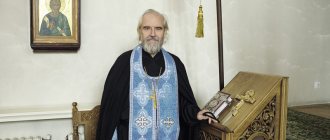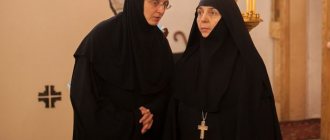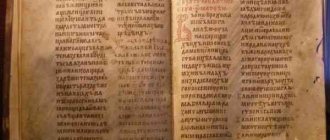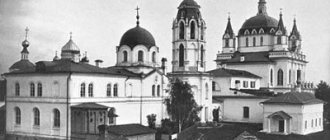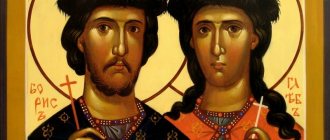The abbot of a monastery is a person who has completely devoted himself to serving God and his community. It is difficult to describe in words all the hardships and responsibilities that fall on the shoulders of a monk who has assumed this position. Nevertheless, they never lose heart, because all their work is aimed at saving as many souls as possible - to bring them out of the darkness of this mortal world.
So, who is the abbot of the monastery? What are his responsibilities? And how big is the difference between clergy of the Orthodox and Catholic faiths?
An archimandrite is the abbot of an Orthodox monastery
Let's start by answering the first question. There really is no “mandrit” in the Orthodox hierarchy.
The word "archimandrite" is formed in a different way. In Greek it is written like this: ἀρχιμανδρίτης - and consists of two parts:
- ἄρχων—leader, leader, boss, head;
- μάνδρα - sheepfold, in the sense of the place where sheep are kept, or “shed”, “fence”.
You should immediately be careful and avoid literal translation.
“The leader of the stables” is, of course, the cost of the difference in languages. The implication is that the archimandrite is the person who is in charge of the place where the lost sheep live. This is a clear allusion to the words of Jesus Christ:
Matthew 18:12
“What do you think? If someone had a hundred sheep and one of them got lost, wouldn’t he leave the ninety-nine in the mountains and go looking for the lost one?”
Sheep are an offensive symbol for Russians by today's standards, but for their era it was a wonderful illustration. So, believers are sheep who are kept in the herd.
Its owner is God, and the representatives of the clergy are a kind of replaceable shepherds who take care of Christians and represent the Almighty on earth.
The archimandrite is close in position to the Catholic abbot.
An archimandrite is a governing group of such sheep, a community of monks. Today we understand the word “monastery,” but at one time it was more appropriate to talk specifically about communities.
So an archimandrite is a monk-priest from the black clergy, almost always the abbot of a monastery.
Catholics have a similar title - abbot, that is, the head of the abbey. And then there is the abbess, that is, the abbess, or in our opinion, the abbess.
Archimandrite Tikhon (Secretary)
Hierarchy in the Church: Key Points
Believing Christians, one way or another, interact with the clergy: when visiting a church live or when watching video broadcasts. And if you are even very far from understanding the hierarchy in the Orthodox Church, then you cannot help but notice that each minister has his own rank.
This is indicated by the different colors of the clergyman’s clothing, headdress, and the presence of jewelry with precious stones or more discreet items.
Find out what awaits you today - Horoscope for today for all zodiac signs
All ranks in Orthodoxy are divided into 2 groups:
- White clergy - we are talking about those ministers who are allowed to start a family and have offspring.
- The black clergy are monks who have completely abandoned all the delights of ordinary life.
And now I propose to consider both categories in more detail.
The archimandrite is the abbot of a large monastery, and the abbot is the abbot of a small one.
Readers savvy in church matters have the right to ask: what is the difference between an abbot and an archimandrite?
Very good question. Indeed, both of them are abbots of Orthodox monasteries.
The fact is that in 1764 a secularization reform took place. As a result, Russian Orthodox monasteries were divided into three classes.
The larger the monastery, the higher its maintenance, the more influence it has, the higher the class. For example, the Trinity Lavra of St. Sergius is a first class monastery.
Archimandrite
this is a monk-priest from the black clergy, almost always the abbot of the monastery
The archimandrite was the abbot of monasteries of the first and second classes. He also wore the appropriate attributes during services:
- mantle with “tablets”;
- pectoral cross;
- club;
- miter.
In the modern hierarchy of the Russian Orthodox Church, the abbot stands one step below the archimandrite. Archimandrite himself is the highest rank attained by priests of the second degree. Then the episcopal ranks begin.
See also the article How to become a monk
Books of the Archimandrite
Archimandrite Plato is known not only as a zealous preacher and educational reformist, but also as a writer. His main work is “A Condensation of Russian Church History.” It was published in Moscow in 1805. This is the first scientifically critical study. Plato created it on the basis of chronicles, archives and memoirs. Even in the 21st century, its uniqueness is of great importance. Thanks to this book, the reader can refresh his view of Russian history, trace the role of the Church in its development, and also better understand the colorful character of the Russian people and the Russian state that has developed over centuries.
The holy archimandrite is the bishop who runs the monastery, and the schema-archimandrite is the ascetic monk
Holy Archimandrite
Only a patriarch or diocesan bishop can be called this way.
- The patriarch can be the holy archimandrite in stauropegial monasteries (those that are not directly subordinate to the diocese);
- The ruling bishop becomes the holy archimandrite in monasteries that are subordinate to the diocese.
Since the holy archimandrites are busy people who are unlikely to be able to be in the monastery every day, they appoint a vicar of the monastery (monastery, monastery). This is the authorized representative of the bishop.
See also the article Mitred Archpriest - what does this mean?
Schema-Archimandrite
To understand who this person is, we need to talk a little about the schema.
Schema is an oath of Orthodox monks to lead a particularly ascetic lifestyle. There is a more gentle one, the Lesser Schema, but usually, when they do not specify it, they mean the Great Schema.
A schema-archimandrite is an archimandrite who has accepted the great schema.
A person who takes a vow of ascetic asceticism is equated to an angelic image.
He goes to live separately from the brethren and removes all obedience from himself. He only participates in liturgies and performs the duties of a confessor. Usually schema-monks lock themselves away in order to communicate with other people less often.
Schema-Archimandrite Gabriel (Bunge)
If an archimandrite becomes a bishop, he can also accept the schema, but such cases are rare. The schema presupposes a monastic lifestyle and retirement. And yet there are examples of this in the Russian Orthodox Church.
Appeal to the Archimandrite
Often people who believe and attend churches have to turn to the church clergy. How to contact the clergy? As in others, the spiritual sphere has its own standards of decency. Church etiquette is the rules of conduct, manners, courtesy, and permissibility that have developed over centuries of history on the basis of moral Christian structures.
In Orthodoxy, each clergy is addressed according to their rank, but there are several general forms of address. There is an Orthodox tradition - this is an affectionate address to a priest, for example, father. Basically, they address him this way, or say this if there is a conversation about him. In addition to this colloquial form, there is another - more strict and official, for example Father. When mentioning a priest, they usually say Father Superior, Father (name). It is considered bad form of Orthodox etiquette to combine the rank and name of a priest. A possible, but rare, combination of “father” and the priest’s surname. Of course, in the environment of the temple, the clergy is addressed as “you”. Despite the possible intimacy between speakers, this phenomenon is not ethical in front of other people. Specifically, to the archimandrite? To the archimandrite - this appeal sounds like this: “Your High Evangelism, Father (name).”
The rank of archimandrite appeared in historical documents in the 5th century or a little earlier
For the first time, the rank of archimandrite was mentioned in the Antioch Patriarchate. Already in the 5th century, almost the entire Greek East included archimandrites.
In the acts of the Third Ecumenical Council (431) we can find a petition on behalf of the archimandrite and other monks.
Archimandrites constantly appear in many historical documents:
- They are mentioned by Cyril of Alexandria in his correspondence with Pope Celestine;
- In 448, at the Council of Constantinople, Archimandrite Eutyches was accused of Monophysitism. This document is signed by 23 monastic leaders - all with the titles of archimandrites;
- Emperor Zeno writes in his religious letter “Henoticon”:
Zeno
Emperor of Byzantium
“God’s catholic and apostolic Church, the indestructible and immortal mother of our powers and that the pious peoples, being in peace and unanimity regarding God with the most God-loving bishops, the most pious clergy, archimandrites and monks, bring favorable prayers for our reign.”
And also there:
“Because this impeccable faith protects both us and the Roman affairs; then the godly archimandrites, hermits and other respectable people brought us requests and with tears begged for the establishment of the unity of the holy churches, and for some members of the Church to come into contact with others; since the hater of good has long been trying to dissolve them, knowing that if he begins to fight with the whole body of the Church, he will be defeated.”
Archimandrite of the 17th century Ioaniky (Galatovsky)
The title "archimandrite" was used almost as a synonym for abbot
We can say with confidence what it meant to be an archimandrite at the turn of the 5th and 6th centuries. This title was given to those abbots who were supposed to oversee all the monasteries of the diocese.
This position was then supplanted by the great sacellarii.
After this, the abbots who led the largest and most strategically important monasteries in the dioceses began to be called archimandrites.
But at the same time, it can be noted that at the Council of Constantinople in 535, practically no distinction was made between archimandrites and abbots. These are practically synonyms with the only difference:
- Archimandrite is a title used in official documents;
- Hegumen is a title that is more often used in signatures.
But this difference means practically nothing.
Presbyters, monastic deacons and monks without holy orders could become hegumen and archimandrite.
But this trend becomes more complex over time and introduces severe restrictions. Soon, only presbyters retain the opportunity to receive the title of archimandrite.
Emperor Justinian I, in his 120th novella, reports that bishops have the authority to elevate clergy to archimandrites.
Black clergy
Represented by people who have taken monastic vows. Let's consider who belongs to the black clergy.
Hierodeacons and archdeacons
Monks performing the duties of a deacon: help priests during divine services and church sacraments (bringing the necessary attributes, reading prayers).
Archdeacon - occupies the rank of the most senior among the hierodeacons.
Hieromonks
Hieromonk = priest, he conducts various sacred sacraments. This rank can be achieved by representatives of the white clergy who decide to become monks or by people who have been ordained (they receive the right to conduct the sacraments).
Abbots (abbesses)
They act as abbots or abbess of a church or monastery. Previously, this rank was given as a reward for showing merit to the church. And since 2011, the patriarch decided that any abbot of the monastery can become hegumen (abbess).
A characteristic attribute of the abbot is the staff, which he uses when walking around his territory.
Archimandrites
One of the highest Orthodox ranks. The priest who receives it receives a miter. Archimandrites wear black monastic clothing, which distinguishes them from other monks due to the presence of red tablets on it.
And if he also holds the rank of rector of a temple or monastery and has the right to carry a special staff, then he is addressed with the words “Your Reverence.”
Bishops (or overseers)
This rank applies to bishops. Bishops have the greatest grace of God; they are allowed to conduct any sacred rites, even the ordination of deacons. They wear a red robe. The archbishop is the most important of the bishops.
An ancient Christian tradition says that only a bishop is allowed to bless the service in the temple, using an antimis (a scarf with sewn-in pieces of the relics of a holy person).
In addition, the responsibilities of the bishop include control and guardianship of all churches and monasteries located on the territory of his diocese. Bishops are addressed with the words “Your Eminence” or simply “Vladyka.”
Metropolitans
The high ecclesiastical rank, the highest of the titles of a bishop, is the oldest on earth. The Metropolitan is subordinate only to the Patriarch. You can understand that this is a metropolitan if you look closely at his attire:
- wear a blue robe;
- have a white hood with a cross, inlaid with precious minerals (and all representatives of lower ranks wear black hoods).
You can become a metropolitan only by showing great merit to the church.
Venerable Eupraxia - the first female archimandrite
A particularly interesting episode in the history of archimandrites is the presence of women among them. Today in the Russian Orthodox Church it is difficult to imagine, but this happened in the bosom of our church tradition.
Women were called abbess, as they are now, but there were also archimandritis.
The very first of the archimandrites is the Venerable Eupraxia of Constantinople (Tavenis).
She was born in 383 in Constantinople, into the family of Antigonus, a nobleman and relative of King Theodosius the Great, and a woman named Eupraxia (the same as her daughter later).
The family was distinguished by piety, generously distributing alms, but one day disaster struck - the father of the family died. The inconsolable mother decided to go to Egypt, where she became interested in the life of the women's community near Thebaid.
However, Abbess Theodula flatly refused to accept financial assistance. She allowed only a few things to be transferred to the monastery:
- Candles;
- Oil;
- Incense.
In addition to the gifts, the mother left in the monastery the most valuable thing she had - her daughter Eupraxia.
This was the desire of seven-year-old Eupraxia herself. The girl dedicated herself to the ministry with zeal, and her mother soon died.
When Eupraxia was left an orphan, Tsar Theodosius sent her a letter in which he reminded her that she had been engaged to the son of a senator since she was five years old.
But the future saint declared that she did not intend to fulfill this obligation, since she had a more important duty—to Christ.
Venerable Eupraxia - the first known archimandrite
Then Eupraxia generously disposed of the family estates - donated them to the needy and to the Church.
Eupraxia led a very difficult life:
- Performed many obediences;
- Ate once a week;
- She suffered attacks from sisters who were jealous of her;
- She received many injuries during her labors (fell into a well, hit her leg with an ax, and injured her eye with a log).
But the difficulties did not frighten Eupraxia, and she soon acquired wonderful abilities:
- Healed the sick;
- Cast out demons;
- I saw the Virgin Mary surrounded by angels;
- She predicted her death ten days in advance.
She died early, at thirty years old, in 413.
Since the mother-in-law is also canonized, “younger” or “maiden” is usually added to Eupraxia’s name.
Archimandrites of the Trinity-Sergius Lavra
Archimandrites are righteous people who lead parishioners on the true path. Their knowledge, faith and philosophy make even a deeply unbelieving person think.
It is impossible not to mention the first archimandrite of the Trinity-Sergius Lavra - Eleutherius of Illyria. He was born into a family of a noble Roman; Christianity was instilled in him by his mother. At the age of twenty he was appointed Bishop of Illyria. During the reign of Emperor Hadrian, Saint Eleutherius and his mother were executed for boldly preaching about Christ after being tortured. Eparch Koriv, who beheaded the holy martyr, believed in Jesus and was also executed.
Plato (Levshin) - Church leader, preacher, teacher, writer. Peter Georgievich's life as a black clergy began in 1758. This year he was tonsured a monk, becoming Plato, at the Trinity-Sergius Lavra. After that, he taught theology, then became the vicar of the Lavra. His preaching attracted the attention of Catherine II, who appointed him teacher of the future Emperor Paul I and court preacher. Plato distinguished himself by transforming the Slavic-Greek-Latin Academy. The period of his ministry was the spiritualization of the educational and educational system.
In the Russian Orthodox Church, archimandrites served as governors of monasteries from the 12th century
In the Russian Orthodox Church, the title “archimandrite” has been known since the 12th century. One can only guess what exactly the Russian archimandrites were like in that era. There is almost no written evidence.
But there is no reason to doubt that people with these titles did approximately the same thing as their “colleagues” from the West: they managed large monasteries. But the abbots did not coexist with the archimandrites for long.
Soon, the title of archimandrite was applied to any abbot.
As mentioned above, in 1764, abbots of first and second class monasteries began to be called archimandrites. At the same time, there was no gap between position and dignity. To lead a monastery, one had to become an archimandrite, and those who had such a rank, but did not manage the monasteries, were counted on one hand.
What did these titular archimandrites do? They were not idle and served as assistants in those monasteries where the holy archimandrites (bishops) were in charge.
Notes[ | ]
- ↑ 1 2 3 Zheltov M.S.
Archimandrite // Orthodox Encyclopedia. - M.: Tserkovno-nauchny, 2001. - T. III: “Anthimiy - Athanasius.” - pp. 577-578. — 752 p. — 40,000 copies. — ISBN 5-89572-008-0. - Chudinov A. N.
Dictionary of foreign words included in the Russian language. — 1910. - ↑ 1 2 3 Voronov A. A.
Spaso-Preobrazhensky Monastery on the Forest // Monasteries of the Moscow Kremlin. - M.: Publishing house Pravosl. St. Tikhon's humanist. University, 2009. - 160 p. — ISBN 978-5-7429-0350-5. - Bishop's official. Book 1. Rite performed during the performance of an archimandrite
Today, archimandrite is a title equal to mitred archpriest
But, in the end, the archimandrites were separated from the governors. This happened because of the disasters that the Soviet government brought upon the Church.
Monasteries in the Soviet Union were closed everywhere, so the archimandrites remained, but there was nowhere for them to serve.
The staff is an attribute of the archimandrite who runs the monastery
Today, archimandrite is primarily a rank or title. Only the patriarch can elevate him to it. Previously, these powers belonged to the Holy Synod.
In seniority, the archimandrite is equal to the mitred archpriest. If an archimandrite serves as a governor or abbot of a monastery, he is awarded a staff.
By leaving a comment, you accept the user agreement
Women's and men's temples. Abbots
The responsibilities of the head of a nunnery and a monastery are somewhat different. Since the abbess does not have the right, according to the Christian faith, to conduct ceremonies of priesthood.
Based on this, it is worth taking a closer look at what exactly the abbot of a monastery should do.
The abbot, unlike the abbess, is obliged to conduct all church rituals. He also has the right to confess people. The abbess of a nunnery has no right to do this. In the event of the abbot's premature death or illness, his duties are assigned to the treasurer on a temporary basis. After which the clergy considers new candidates for the vacant post and makes a decision.
It should also be noted that the roles of the rector of the Catholic and Orthodox churches are somewhat different from each other. What exactly? We will look at the features of each below.
